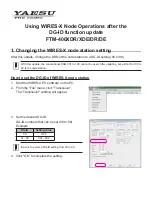
23
FT-8800R Operating Manual
B
ASIC
O
PERATION
T
RANSMISSION
To transmit, simply close the
PTT
(Push To Talk) switch on the microphone.
The
FT-8800R
will transmit only on the “
Main
” band. During transmission, the “
”
icon will appear at the upper right of the “
Main
” frequency field on the display.
Changing the Transmitter Power Level
You can select from among a total of four transmit power levels on your
FT-8800R
.
To change the power level, press the [
LOW
] key to select one of four power settings. These
power levels will be stored, in memory registers, at
the time of memory storage (see page 32 for details
on Memory operation).
During transmission, the Bar Graph will deflect in the display, according to the power out-
put selected.
You may change the power level on the “Main” band using the microphone’s
[
P4
]
key.
LOW
5 W
MID 2
10 W
MID 1
20 W
HIGH
50 W: 144 MHz
35 W: 430 MHz
Notice
The
FT-8800R
may receive very strong signals on the Image frequency, and/or the receiver
sensitivity may be somewhat reduced by the combination of the “
Left
” and “
Right
” band
frequencies while Full Duplex operation is engaged.
If you experience interference that you suspect may be coming in via a frequency “Mix,” you
may calculate the possible frequencies using the formulas below. This information may be
used in the design of effective countermeasures such as traps, etc.
“
Right
” band 144 MHz TX freq.
–
100.35 MHz
=
“
Left
” band IF freq. or “
Left
” band 2nd IF freq. Image
144 MHz TX freq. x
n1
–
(430 MHz RX freq.
–
45.05 MHz) x
n2
=
“
Left
” band IF freq. or “
Left
” band 2nd IF freq. Image
144 MHz TX freq. x
n1
–
(430 MHz RX freq.
–
45.05 MHz) x
n2
+
11.15 MHz =
“
Left
” band IF freq. or “
Left
” band 2nd IF freq. Image
430 MHz TX freq. x
n1
–
(144 MHz RX freq.
+
45.05 MHz) x
n2
=
“
Left
” band IF freq. or “
Left
” band 2nd IF freq. Image
(
n
is an integer: 1, 2, 3, …)
Downloaded by
RadioAmateur.EU
















































